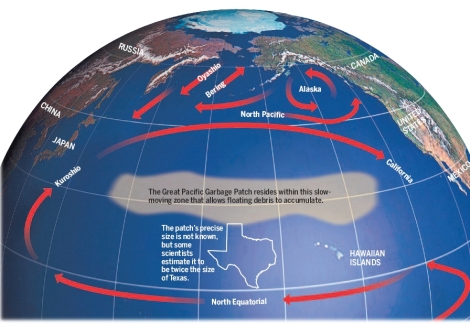Considered for a long time as a myth, the existence of the garbage continent is now a fact. Few have been fortunate enough to see how this continent looks like. I now on belong to this group of people which had this chance. Since Copenhagen’s climate change conference in 2009, I have realized how important it is to protect the planet. I felt that I had to see this phenomenon and to realized how badly humanity has been polluated the sea. I, Peter Wayne, am an ordinary man but one day I have chosen to do something unusual. I took a job on the boat where scientists were going to the 8th continent in northern Pacific. It was truly an adventure to go there, in the middle of nothing, or I rather say in the middle of plastic. The discovery of this new continent is facisnating. First of all it was by chance. It was a sailor, Charles J. Moore who after a race returned to America in 1997 and ended up in an area full of mostly plastic items. A bit before this race in the 80s many people are already suspected the existence of garbage continent. But can we really call this debris field a continent? As regards size, the area is at least twice as large as Germany. It is not Australia but it is still quite large. Continent or not – we can at least agree that it is the world dustbin. All the garbage ends up eventually in that area because of a current. This current travels around the North Pacific stream passes by the U.S. west coast in a southerly direction, turns and continues towards the middle of the Pacific Ocean until it turns north and reaches Japan and then Russia’s east coast, continues westward and then turns south at Alaska. This large vortex called “the North Pacific Gyre” attracts all debris to its center. At first I though that one could walk on this continent, but after all it looks more like a garbage soup.
Rubbish layer is on average 30 meters thick and there are about 18500 “junk stuff” per square kilometer, of which eighty percent plastic. It is said that the plastic will disappear after a few centuries but not in the way you might imagine. The plastic actually breaks down into small pieces until it reaches the plankton size and is thus invisible to the naked eye. Now and then I saw an albatross that ate up a cap and then I understood really how garbage directly affects the environment. The bird thought for sure the cap was some colorful fish. The scientists told me about a bird they found with a stomach that contained dozens of such capsules. Nevertheless the worst are the small plastic bits. They are so small that fishermen may not see them, the plastic is litteraly in the blood vessels of birds and fishes. Another problem is that organic toxins from sea water (such as DDT and PCBs) are absorbed by plastic pieces. These toxines and the plastic is at the end of the food chain simply eaten by the humans. This means that we do not only get the plastic in us but also other poisons. You can wonder now if you may have some of these plastic bits in your blood? The truth lies a simple blood test. It’s hard to find something positive regarding the garbage continent but once the scientists told me about a funny incident that happened in this area in 1992. This specific year a boat lost in the Pacific garbage continent thirty thousand yellow plastic ducks, plastic blue turtles and green plastic frogs. The sea became suddently an huge bathtub, the dream for all children and probably also for some adults. In such case what would you wait for to jump into the bath? Pack the towel and shampoo and dive into the world’s largest bathtub!
This novel is based on true facts
